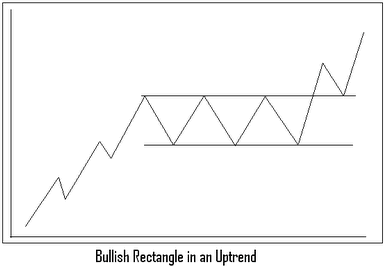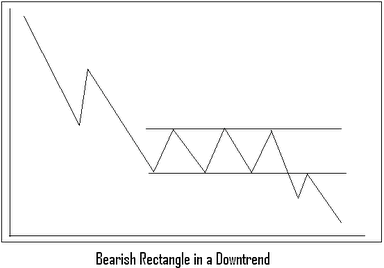The rectangle is also referred to as a trading range or congestion area. It's easy to spot on a price chart and represents a pause in a trend during which the prices are moving sideways between two parallel horizontal trendlines.
No matter the name used, this formation usually depicts a consolidation period in the existing trend and is usually in the direction of the preceding trend. It's forecasting ability is similar to the symmetrical triangle except that the trendlines of the rectangle do not converge as they do in the symmetrical triangle.
A decisive close outside either the upper or lower line signals the completion of the rectangle. The trader needs to remain alert to be sure this formantion doesn't result in a trend reversal. He or she could view this pattern in an uptrend and think it could be a top reversal.


One important thing to watch in this formation is the volume pattern. Our trader will see fairly broad price swings in both directions, but needs to note which moves have the higher volume. It's most likely a continuation pattern if the rallies are on heavier volume and the set backs are lighter. A warning sign of a possible trend reversal is when the heavier volume is on the down side.
Some traders trade the swings within the rectangle by buying on the dips and selling on the rallies. Short-term traders, like those who are day trading, can take advantage of this technique and profit from this trendless market move. Here, in the extreme of the range, the risks are relatively small and well defined.
Our swing trader may assume the rectangle is a continuation pattern, and decide to take a long position near the lower end of the price band in an uptrend or a short position near the top of the range in a downtrend. Our option trader may avoid this trendless market altogether and wait for a clearcut breakout before committing to a trade. Most trend following systems perform poorly during a sideways or trendless market.
The rectangle, like the triangle or wedge, takes one to three months to form, but the rectangle's volume differs in that its broad price swings prevent the usual dropoff in activity.
The most common measuring technique is based on the height of the pricing range. Measure the height completely from top to bottom, and then project that vertical distance from the breakout point. This is similar to other vertical measuring techniques used in continuation patterns and is based on market volatility.
With the upper and lower boundaries being horizontal, the support and resistance levels are clearly evident. So on upside breakouts, the top of the former price range provides support for any sell offs. On downside breakouts in a downtrend, the bottom of the trading range, the previous support, now provides a ceiling over rally attempts.
Andy Swan is co-founder and head trader for DaytradeTeam.com. To get all of Andy's day trading, swing trading, and options trading alerts in real time, subscribe to a one-week, all-inclusive trial membership to DaytradeTeam by clicking here.